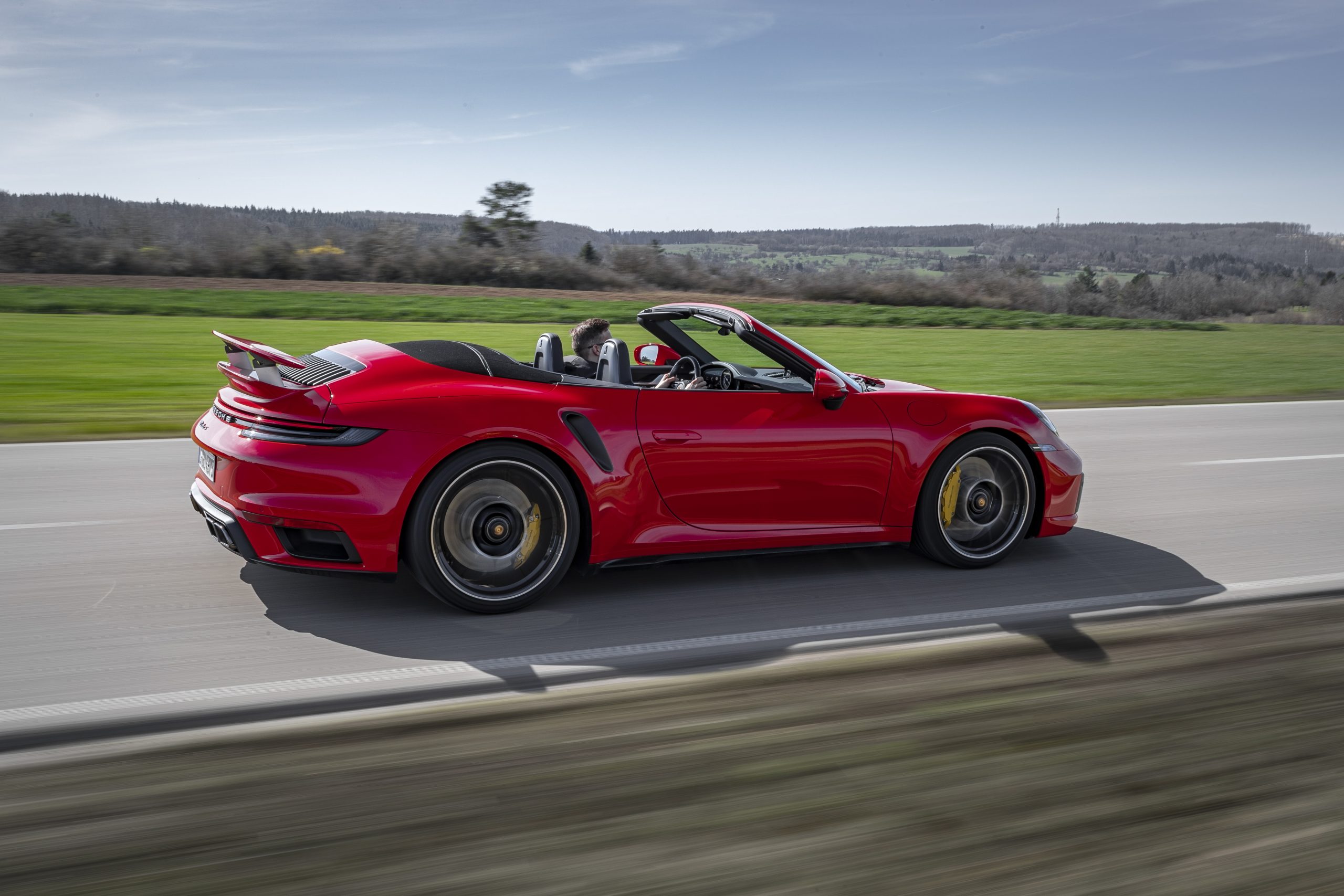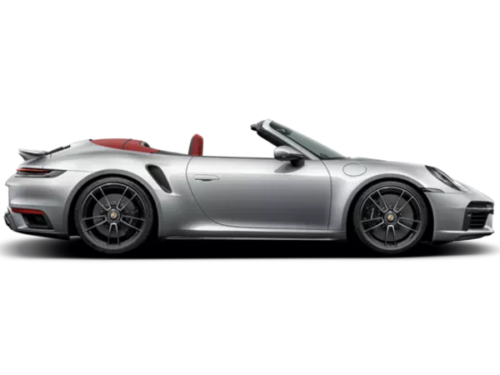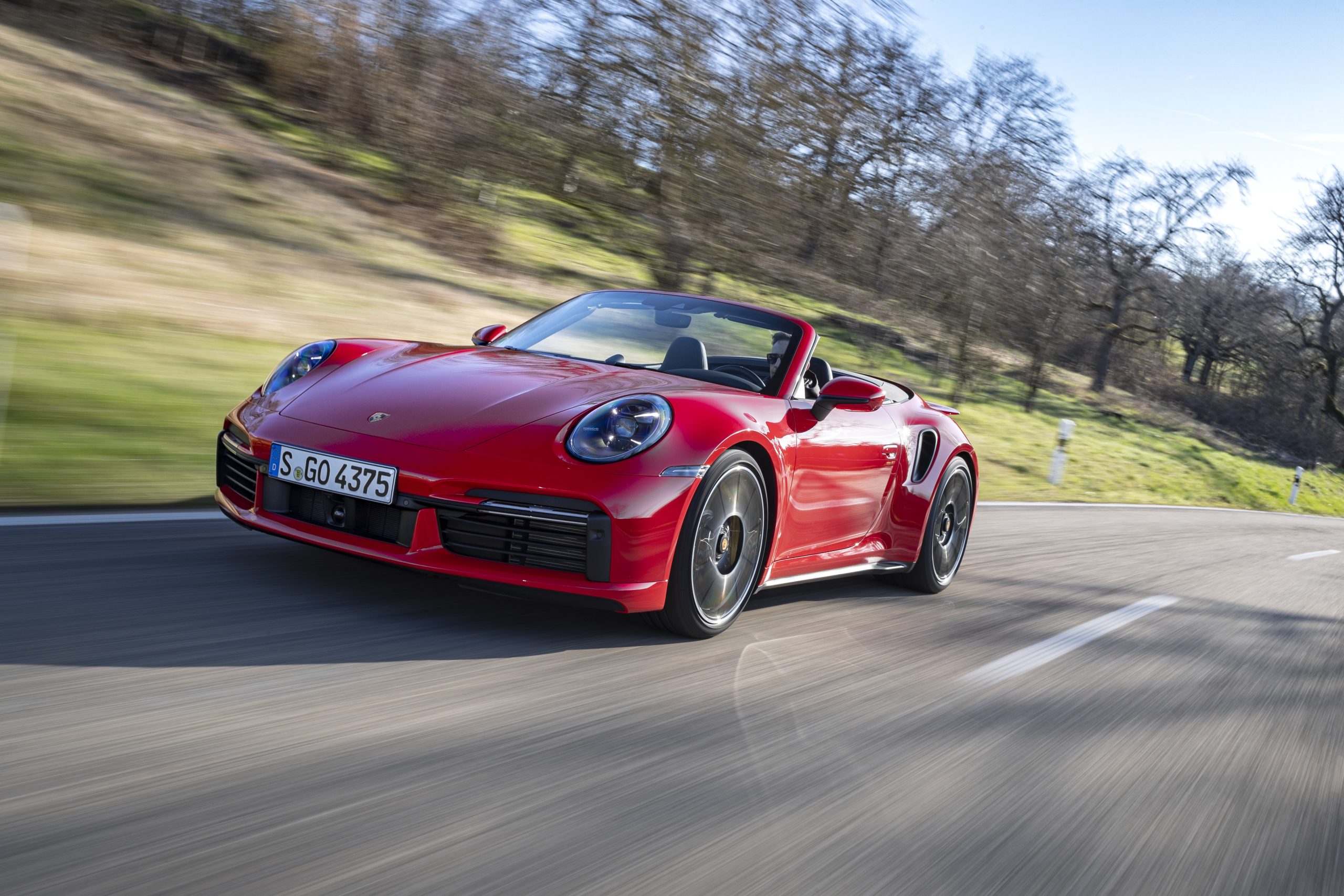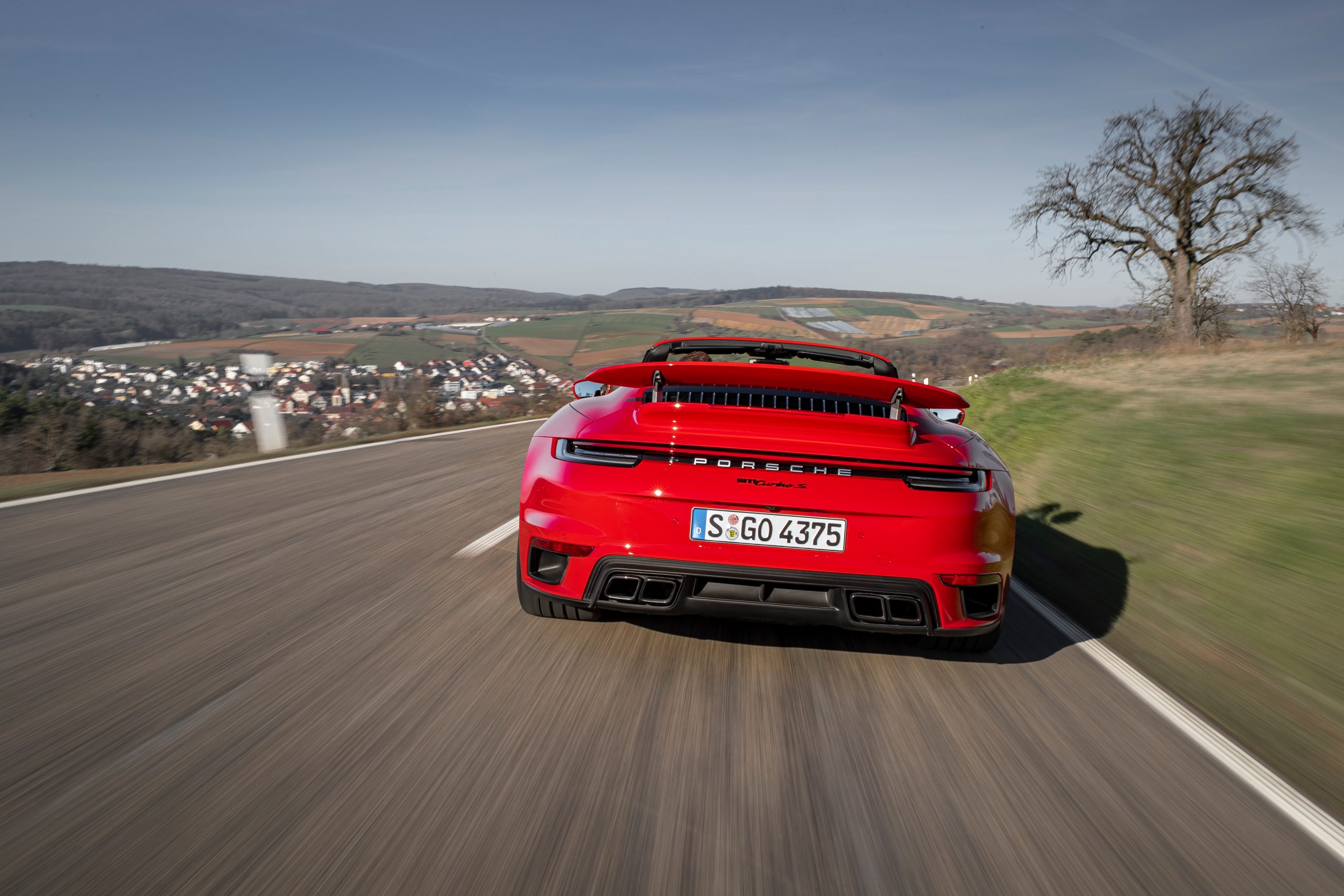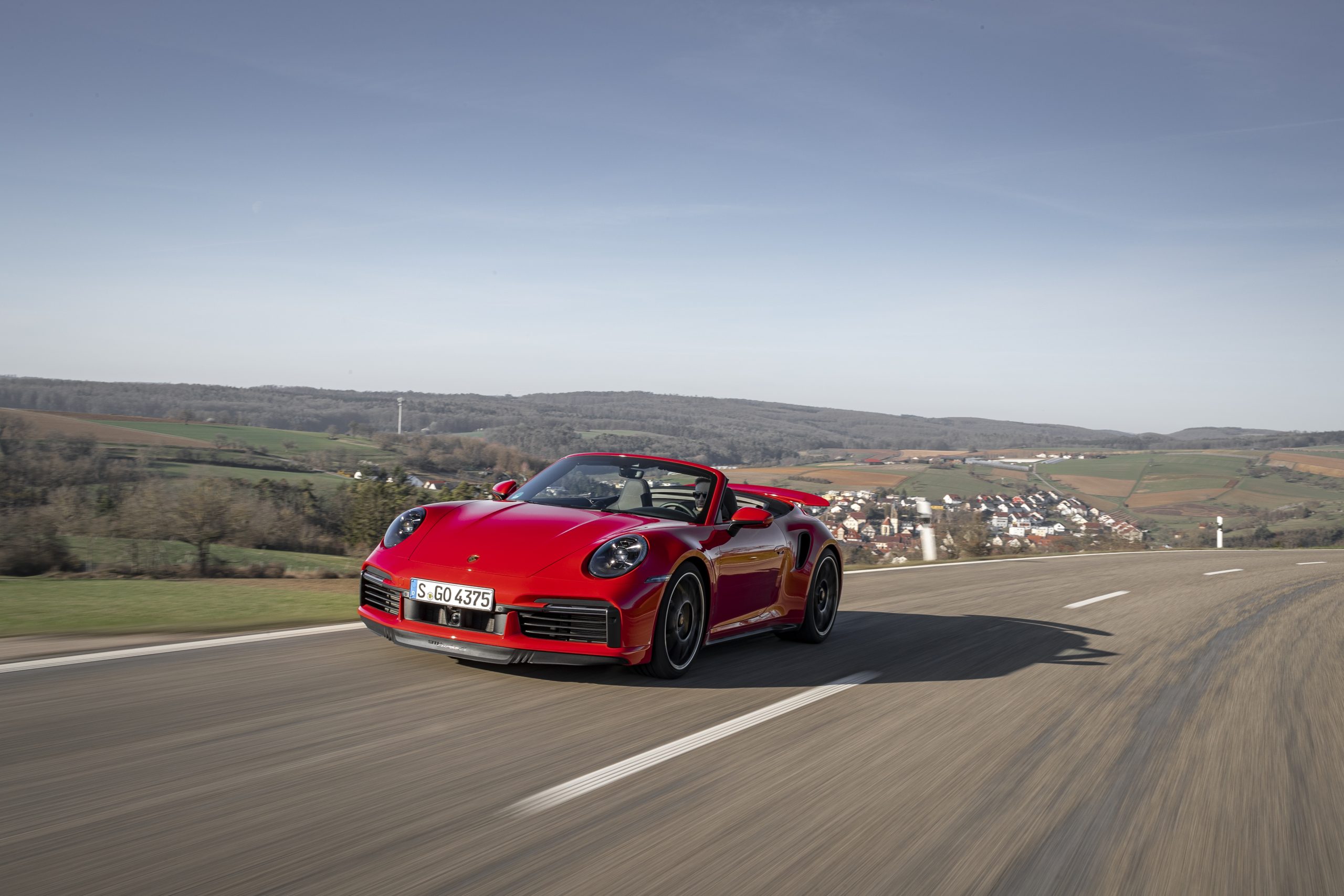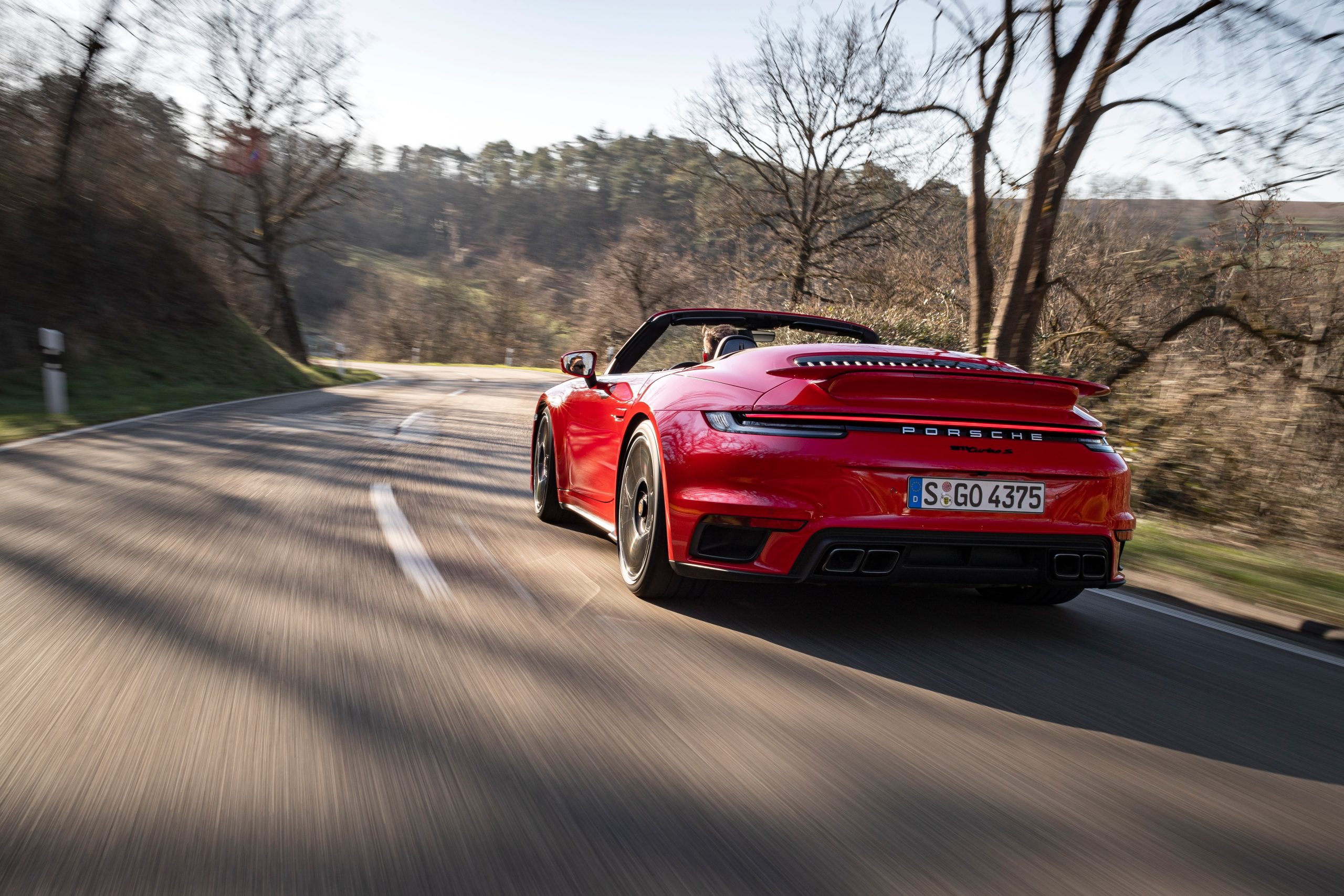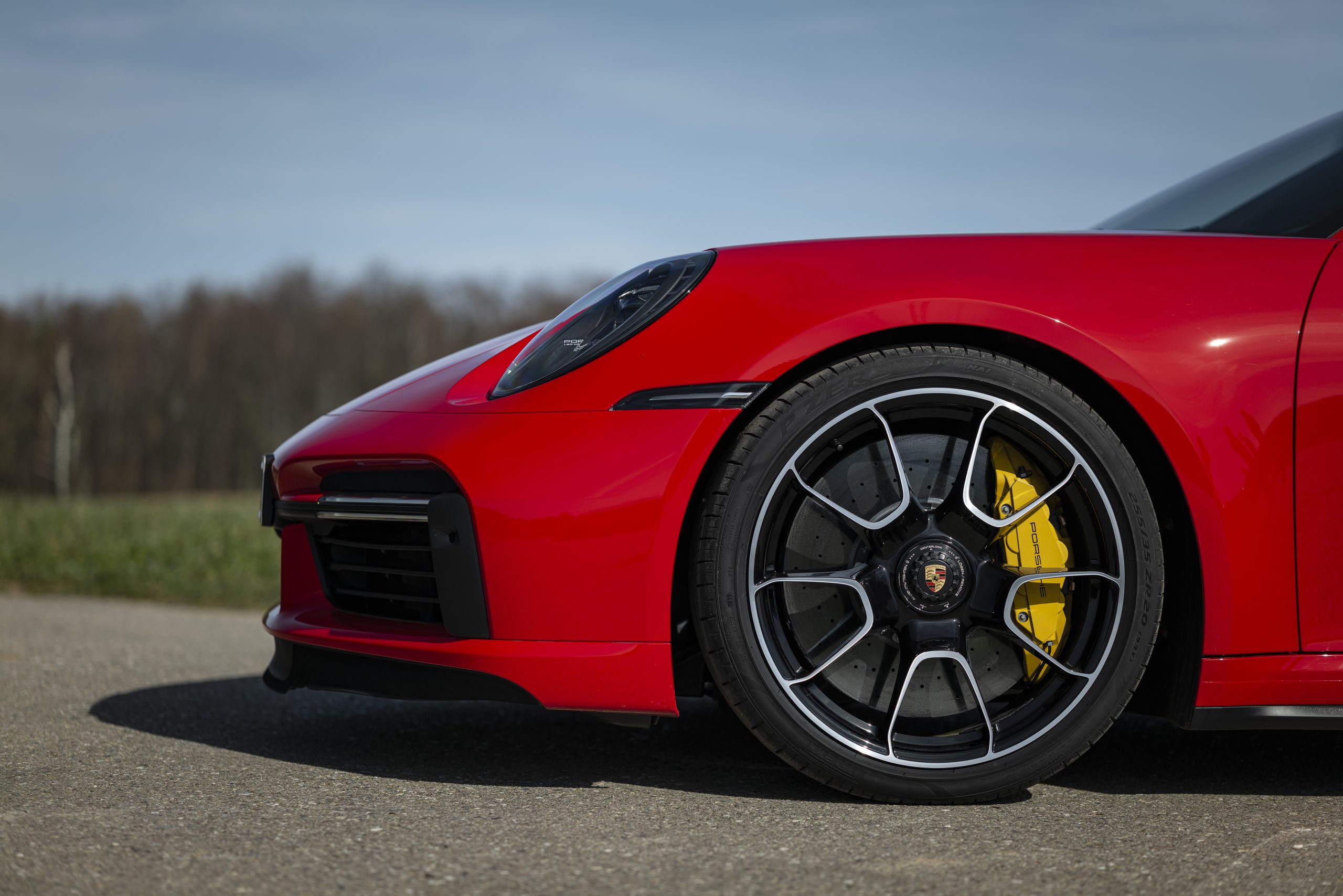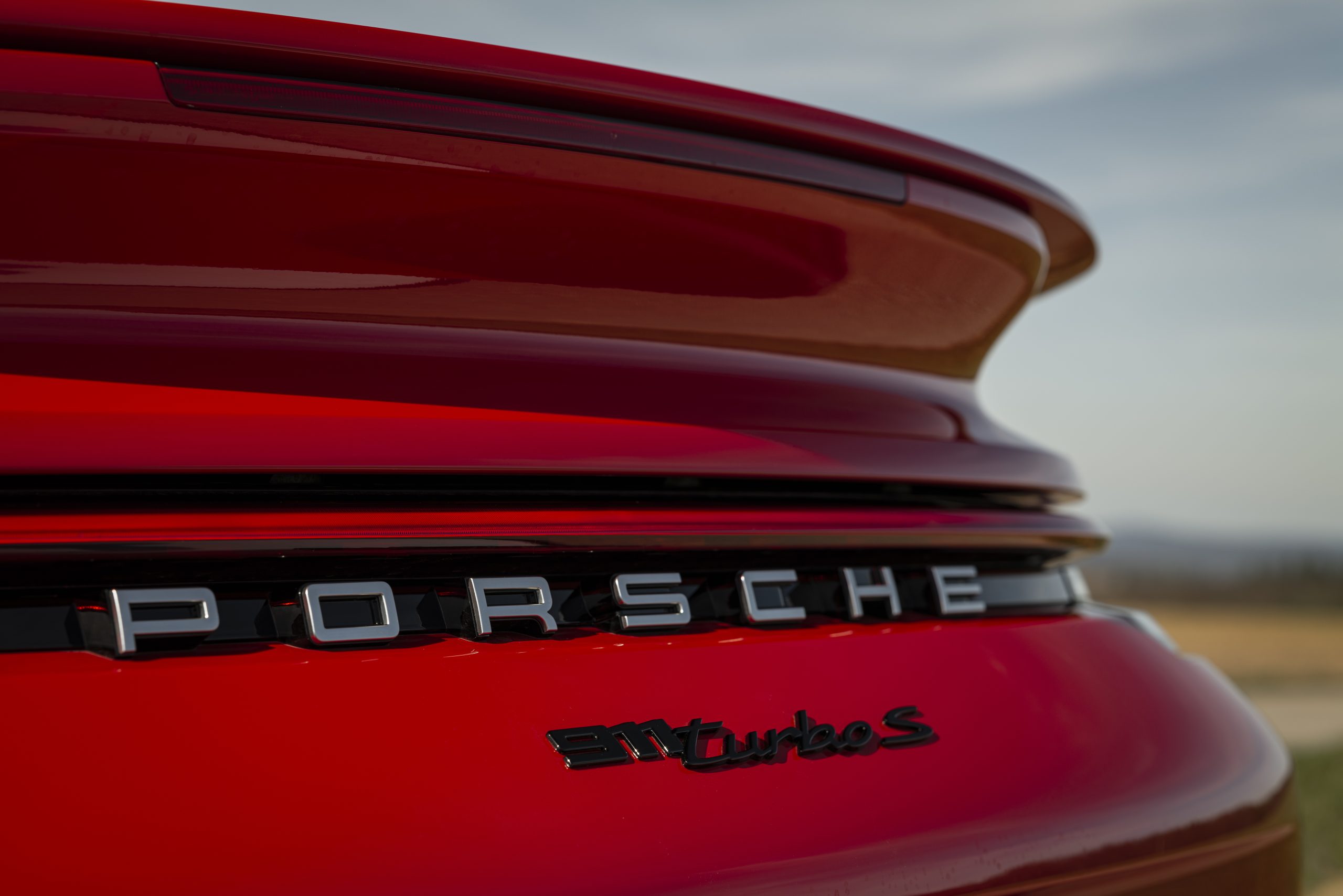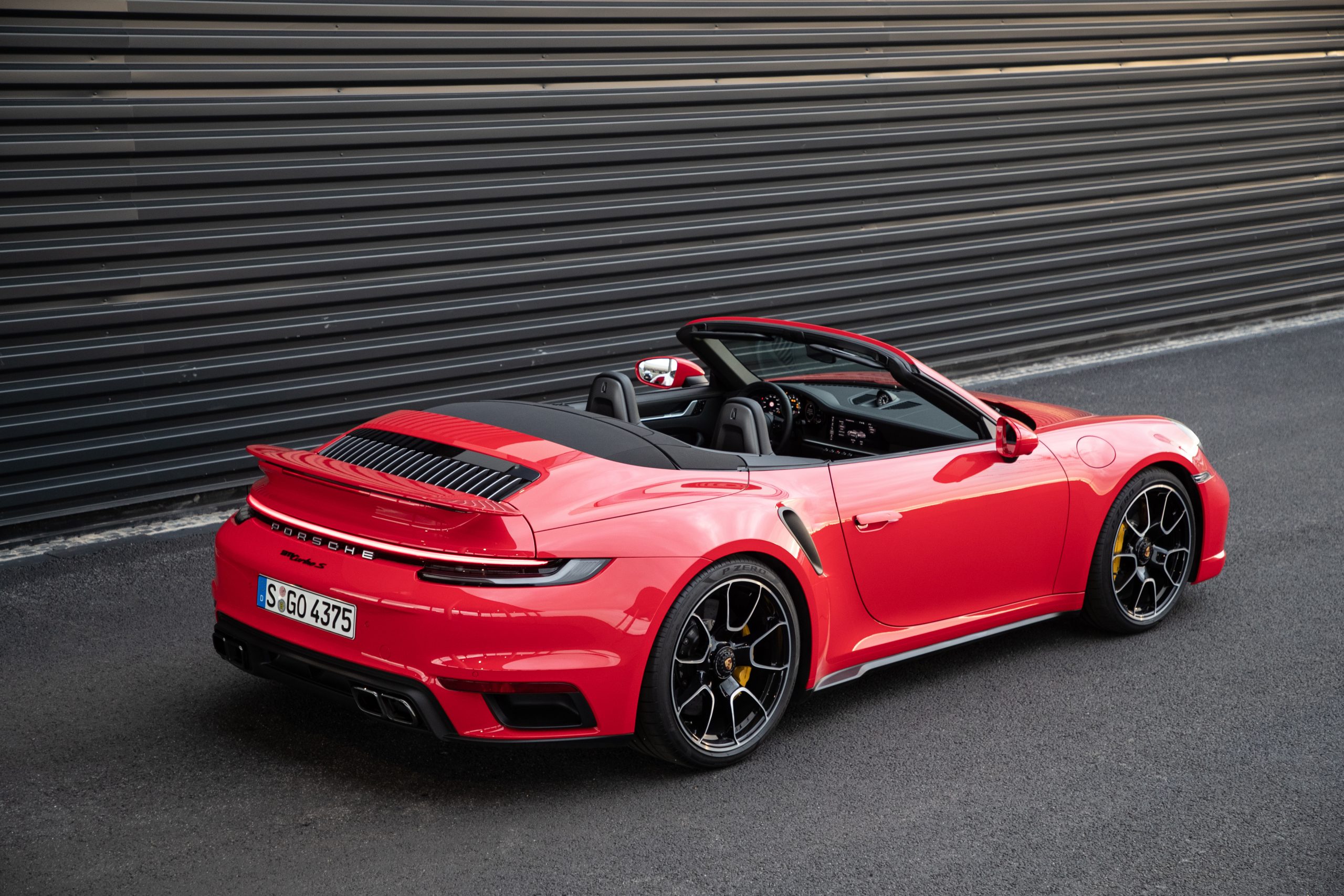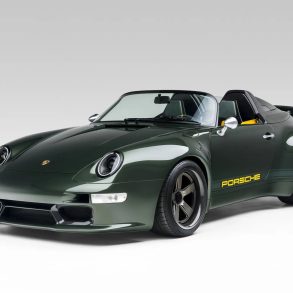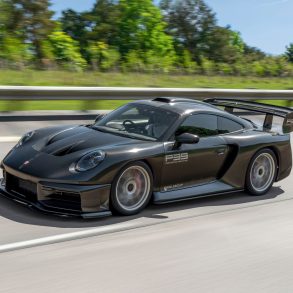Porsche 911 Turbo S Cabriolet (992) – Reviews, Pricing, Specs & Buyers Guide
The 2022 Porsche 911 Turbo S Cabriolet is a formidable beast. The new Turbo S comes with an all-new, 3.8 liter boxer six with two variable turbine geometry (VTG) turbochargers. The power output is a staggering 640 hp and 590 lbs-ft of torque. In keeping with previous Turbo models, the engine powers all four wheels. A new 8 speed automatic transmission with a manual mode manages the power, and can power the car to 60 mph in a hair under a claimed 2.7 seconds. Few cars make this level of performance so accessible.
Carbon ceramic brakes are standard, as are the great looking center-lock wheels. What’s not standard, surprisingly, is a Porsche Active Suspension Management (PASM) Sport suspension. Also-optional is the Sport exhaust package which is a must ($3,490).
The major point of that claim is that the previous generation 700 hp 911 GT2 RS reached 60 MPH in 2.8 seconds. As well, instead of routing cooling and charge air in solely through the classic Turbo model side scoops, two new air intakes are built into the rear lid grille. This allows for charge air to be rammed in via the side scoops, while the grille intakes take a lot of the cooling work. This allows for colder charge air, leading to more power development.
As well, to balance the new power and engine, the turbine wheels of the turbos spin in opposite directions across the car. The right side turbo will spin clockwise, and the left side will spin counterclockwise, to balance against each other like a gyroscope. The turbine wheels are larger at 55 mm, and the compressor wheels are a gargantuan 61 mm. Braking is handled via carbon ceramic brakes as standard, with a ten piston caliper up front.
The front splitter is now an active aerodynamic part, which can be extended from its normal position pneumatically to add up to 15% more downforce. The rear wing guarantees downforce over the rear wheels.
In a straight line, this new 992 Turbo Cabriolet is a beast. 0-60 in 2.7 seconds and a quarter mile time of 10.6 seconds. These are simply hypercar speeds in a comfortable convertible GT. More rewarding still is the way the torque makes overtaking hilariously effortless. You see a gap, squeeze the throttle, anticipate whatever lag might be there based on gear and revs, and then feel an invisible giant’s hand swat the car forward, leaving other traffic simply a dot in the rear-view mirror.
Motortrend: …A 2021 Turbo S Cab will nose ahead of a garden variety 2005 Bugatti Veyron 16.4 in a race to 60 mph by 0.3 second, beat it at every 10-mph gate to 90 mph, and match it at that 5.7-second 0-100-mph figure.
This is a unicorn car. While the GT cars get all the praise, we need to appreciate the Turbo S Cabriolet for what it is. It is a GT car that has surefooted all-wheel drive, a luxurious interior, great dynamics and a convertible top. It has everyday approachability and hypercar performance that anybody can tap. This is the perfect all-rounder for the ones who can afford the entry. This ballistic new 911 Turbo S now takes things to the next level.
Chris Walton: What an absolute monster. There’s nothing it does wrong…The steering loads up beautifully, and you can tell when the front grip starts going away when the steering gets lighter and looser telling you exactly where you are in the grip.
Updates and Pricing for 2022
Prices for the 2022 Porsche 911 Turbo S Cabriolet start at $217,650 (including mandatory destination charges of $1,350). There are two new factory options on the 992 Turbo S: Porsche’s Active Suspension Management sport suspension and a sport exhaust. The sport suspension system lowers the Turbo’s ride height by 0.4 inch, and the sport exhaust has oval tailpipes and adjustable exhaust flaps. Standard equipment includes Porsche dynamic chassis control, rear-axle steering, and ceramic composite brakes, now with 10-piston front calipers and 420mm front rotors.
Porsche upgraded the infotainment system on the 2022 911 to include a new 10.9-inch touchscreen interface that the company calls both simplified and flexible in its personalization. It comes with wireless Apple CarPlay, and for the first time, the 911 gets Android Auto compatibility. Porsche also extended its connected services from one year to three years before reverting to a subscription model. Those services include natural voice commands activated by “Hey Porsche,” online map updates, and navigation with real-time traffic info. Satellite radio also gets a three-month trial.
Reviews
Pictures
Sales Brochure
Press Release
The 2021 911 Turbo S Coupe and 911 Turbo S Cabriolet
911 flagship with 60 hp more than before
The 911 Turbo S models are powered by the most powerful 911 engine current available. Two VTG turbochargers help the 3.8 liter boxer engine to deliver 640 hp. With this new model, the torque has increased by 37 lb.-ft. compared to the previous generation.
Improved acceleration
With the eight-speed PDK, which was modified specifically for the Turbo S, the sprint to 60 mph has been cut to 2.6 seconds (0.2 s faster than before) while top track speed is 205 mph. The new 911 Turbo S accelerates from zero to 124 mph (200 km/h) in just 8.9 seconds, taking a full second off its predecessor’s time.
Increased track widths
Modified track widths contribute to the agility and performance: the track is now 1.65 inches at the front axle and 0.39 inches wider at the rear axle than on the previous 911 Turbo S.
Wider tires with Turbo-specific dimensions
Like the 2020 911 Carrera S models, the new 911 Turbo S is fitted with larger-diameter, 21-inch wheels and tires on the rear axle to optimize traction and handling. Porsche uses 20-inch wheels at the front and, for the first time, specific tire dimensions (255/35 R 20 front and 315/30 R 21 rear) for the 911 Turbo S that are wider than on 911 Carrera S models (245/35 R 20 and 305/30 R 21).
Enhanced Porsche Ceramic Composite Brake (PCCB)
As before, 911 Turbo S models are equipped with Porsche Ceramic Composite Brakes (PCCB) as standard. The front rotors have grown in size from 410 to 420 mm. Additionally, the Turbo S is the first Porsche 911 to be fitted with 10-piston fixed front calipers.
Sportier character with new performance options
A PASM Sport Suspension, which includes a 0.39 inch (10 mm) lower ride height, is optionally available for the first time. This gives the 911 flagship an even sportier feel. The newly developed optional Sport Exhaust System provides a particularly distinctive sound.
Enhanced aerodynamics
Porsche Adaptive Aerodynamics (PAA) now feature controlled cooling air flaps at the front, extended control strategy and a larger but lighter rear wing for even more downforce. The PAA also acts as an air brake when decelerating at high speeds.
Optional
New lightweight and noise-insulated glass For the first time, newly developed lightweight and noise-insulated glass is optionally available for the 911 Turbo S Coupé, resulting in a weight savings of more than 8 pounds.
Extensive standard equipment with and leather upholstery with unique stitching pattern
The standard full leather interior includes Turbo-specific stitching, reminiscent of the first 911 Turbo (930). Standard equipment includes 18-way Adaptive Sport Seats Plus, the GT Sport steering wheel, Sport Chrono package and BOSE® Surround Sound system.
Summary
The 2021 Porsche 911 Turbo S and 911 Turbo S Cabriolet Porsche is presenting the new-generation 911 Turbo S. The new range-topping 911 is the quickest and most powerful 911 Turbo model ever. With 640 hp, it offers an unprecedented combination of power, driving dynamics, and everyday usability.
A new 3.8-liter boxer engine with two VTG turbochargers represents the beating heart of the car and puts out 60 hp more than its predecessor. Maximum torque now stands at 590 lb.-ft. – an increase of 37 lb.-ft. The engine is paired with a Turbo-specific eight-speed Porsche Doppelkupplung (PDK) dual-clutch transmission. As a result, it goes from zero to 60 mph in just 2.6 seconds (2.7 seconds for the Cabriolet), which represents a 0.2 second reduction compared to the previous model. The 911 Turbo S Coupe reaches the standing quarter mile mark in 10.5 seconds. Top track speed for both Turbo S models is 205 mph.
The body of the new 911 Turbo S is wider than its predecessor to further enhance driving dynamics: it’s now approximately 1.8 inches wider at the front (72.4 inches), and the overall width is 74.8 inches at the rear axle (an increase of 0.78 inches) to make room for wider track widths as well as larger wheels and tires. Modified track widths, optimized aerodynamics, and new tires contribute to its agility: the track is now 1.65 inches wider at the front axle and 0.39 inches wider at the rear axle. The adaptive aerodynamics now include adaptive cooling air flaps at the front, while the larger rear wing has been designed to provide even more downforce. For the first time, the 911 Turbo S transfers its power to the road using staggered center-lock wheels in two different diameters: 20-inch wheels at the front are wrapped in model-specific 255/35 tires, while the 21- inch rear wheels use 315/30 tires. The front and rear tires are 10 millimeters wider than on 2020 911 Carrera S models and compared to the previous 911 Turbo models.
Two new factory options, which were not available on the previous generation, further increase the performance and powerful character of the new 911 Turbo S: The Porsche Active Suspension Management (PASM) Sport suspension with a ride height lowered by 0.39 inches (-10 mm) compared to the standard PASM suspension, and the Sport Exhaust System with adjustable exhaust flaps and distinct oval tailpipes that guarantees a particularly distinctive sound. Like on the previous 911 Turbo S, Porsche Dynamic Chassis Control, rear-axle steering and Porsche Ceramic Composite Brakes, now with 10-piston front calipers, are standard. The front brake rotors have increased in size from 410 mm on the previous model to 420 mm.
The new 911 Turbo S
Details The new engine of the 911 Turbo S is based on the current 911 Carrera engine generation. It features a completely redesigned charge air cooling system; new, larger variable turbine geometry (VTG) turbochargers in a symmetrical layout with electrically adjustable wastegate flaps; and piezo injectors, which significantly benefit the vehicle’s responsiveness, power, torque, and its free-revving nature. The new six-cylinder is engine fed with air via a new intake system. The previous routing of process air and charge air cooling was reversed: The charge air coolers, which are 14 percent larger than on the previous model, have been moved from their previous position in the rear fenders to directly behind the engine, increasing the flow rate of cooling air by about 13 percent. The air filters are now positioned in the rear fenders, with air being fed via four intakes located laterally below the rear wing and in the rear side panels with a larger overall cross-section and lower resistance, helping to improve engine efficiency. Two symmetrical turbochargers with variable turbine geometry (VTG) and larger internals replace the previous parts, with wheels now rotating in opposite directions on the left and right side of the vehicle. The diameter of the turbine wheels has been increased by five millimeters to 55 mm, while the 61 mm compressor wheel is now three millimeters larger than before. The wastegate flaps are electrically controlled using stepper motors.
Highlighting driving pleasure and performance, the new 911 Turbo S models is equally well suited for everyday use as well as the racetrack. The leap in performance of this new generation is particularly noticeable in the acceleration from zero to 124 mph (200 km/h): at 8.9 seconds, the new 911 Turbo S Coupe is one full second quicker than its predecessor. Thanks to the enhanced Porsche Traction Management (PTM) all-wheel drive system, the transfer case can distribute significantly more torque, with up to 368 lb.-ft. sent to the front wheels. The new generation of the standard PASM chassis has also been retuned to offer even better handling. Faster and more precisely controlled dampers provide significant advantages in terms of roll stability, road holding, steering behavior and cornering speeds. Like on the 911 Carrera models, Wet Mode is standard. This function detects water on the road, automatically preconditions the stability control and antilock brake systems accordingly, and warns the driver.
The new front end with wider air intakes has a characteristic Turbo-look with dual front light modules as well as standard LED Matrix-design headlights with dark surrounds. The redesigned, pneumatically extendable front spoiler and the larger rear wing deliver 15 percent more downforce compared to the previous model. The muscular rear fenders with integrated air intakes emphasize the sleek body of the 911 Turbo S. Rectangular tailpipes in high-gloss Black, characteristic of the 911 Turbo S, complete the muscular look. The optional Sport Exhaust System is distinguished by oval tailpipes that can be ordered in high-gloss Black or Silver finish.
The luxurious interior offers standard equipment such as full leather and carbon fiber trim in combination with Light Silver accents. Standard 18-way adjustable Sport Seats Plus feature stitching patterns reminiscent of those on the first 911 Turbo (type 930). High-quality graphic elements and logos in the instrument cluster complete the characteristic Turbo S features. Just like in the latest 911 Carrera models, the center touchscreen of the PCM now measures 10.9 inches, and offers quick and intuitive operation thanks to its new layout. Other standard features on the new 911 Turbo S models include the GT Sport steering wheel, the Sport Chrono package with newly integrated Porsche Track Precision app and the BOSE® Surround Sound system.
The 2021 Porsche 911 Turbo S Coupe will be priced at $203,500, while the 911 Turbo S Cabriolet will retail for $216,300 (prices exclude the $1,350 delivery, processing and handling fee). Both models will be available to order soon and are expected to reach U.S. dealers in late 2020.
Body & Aerodynamics
Muscular appearance with wider front and rear track
The improved driving dynamics of the Porsche 911 Turbo S are clear to see. Track widths are now 1,600 mm (up by 10 mm) at the rear and 1,583 mm at the front (up by 42 mm). The 911 Turbo S has wider tires and newly designed wheels to accommodate its increase in power: 20- inch tires with their new 255/35 size at the front and 21-inch tires measuring 315/30 at the rear. The new front fascia with wider air intake openings has a characteristic Turbo look with dual front light modules. The newly designed, pneumatically extendible front spoiler ensures aerodynamic performance, while the muscular rear quarter panels with integrated air intakes accommodate the increased track width. At the same time, although lightweight in appearance, the rear wing delivers the required downforce. The new rear fascia, with its typical Turbo-style rectangular twin tailpipes in high-gloss black, rounds off the appearance of the back of the car, together with a light bar that is characteristic of the current 911 generation. The standard LED Matrix design headlights with dark surrounds are another distinguishing feature of the new 911 Turbo S. A version with black surrounds is available as an option.
Adaptive aerodynamics with extended control strategy and additional functions
The adaptive aerodynamics – launched as a world first on the previous model – have been further refined and extended for the new 911 Turbo S. New functions include Wet mode and air brake. If the standard sensors detect a wet road surface, the driver will be notified by a message in the instrument cluster. The driver can then activate Wet mode using the rotary switch on the steering wheel. The aerodynamic control systems then switch the balance to generate a higher downforce on the rear axle, which in turn increases the contact between the tires and road.
Furthermore, the 911 Turbo S features an air brake function. In case of emergency braking at high speeds, the front spoiler and rear wing are moved to the performance position. The higher drag force and increased downforce reduce the braking distance, depending on the initial speed and road conditions. Driving stability is also improved during braking with this feature.
The optimized active aero systems enable even better adjustment of the car’s aerodynamic properties to suit different driving requirements. The newly designed active front spoiler and rear wing increase downforce by 15 percent compared to the previous 911 Turbo S to guarantee enhanced driving stability and dynamics at higher speeds. Maximum downforce in the performance position (Sport Plus mode activated) is now around 375 pounds (170 kg). When track speeds exceed 160 mph, the rear wing is adjusted to a slightly flatter angle in the performance position. This reduces the maximum load on the rear axle and improves race track performance. In conjunction with the other aerodynamic configurations – Eco, Speed and Wet modes as well as the air brake function – the new 911 Turbo S delivers a greater aerodynamic control range and adapts to the particular driving situation.
New cooling air flaps and larger lightweight rear wing
The newly developed controlled cooling air flaps in the front intakes make it possible to achieve lower drag and improved fuel consumption by closing completely at speeds between 43 mph and 93 mph. The most efficient configuration with a minimum drag coefficient (cd) value is achieved with closed flaps and retracted front and rear spoilers. The flaps open from 93 and are fully open at speeds above 105 mph to improve aerodynamic balance at high speeds. The cd varies depending on the aerodynamic setting from 0.33 in Eco mode to 0.38 in the Performance setting. All active aerodynamic elements have been newly developed. The revamped front spoiler extends 10 mm further than on the previous model. Lightweight construction is also used on the rear wing: the distinctive Turbo feature has an eight per cent larger effective aerodynamic area while the weight of the wing has been reduced by eight per cent or 440 g. The technical structure – a foam core with forged inserts – consists of an upper side with two layers of carbon fiber-reinforced plastic (biaxial CFRP fabric) and a lower side with one layer of glass fiber-reinforced plastic (triaxial GFRP fabric).
New optional lightweight and noise-insulated glass option
Porsche has developed innovative lightweight and noise-insulated glazing for the 911 Turbo S. This composite glass weighs approximately 8 pounds (4 kg) less than the glass in other models. The body weight in the area above the car’s shoulder line, which is important for driving dynamics, is therefore reduced, lowering the car’s center of gravity. Compared to the regular production glass, the lightweight glass is made from thinner outer panes and chemically pre-stressed inner panes. This special glass structure is not just lighter but also more sound-absorbent and is an option that is expected to be offered for all 911 Coupe models from mid-2020.
Engine & Transmission
New twin-turbo engine with major increase in performance
The 911 Turbo S offers a significant increase in performance. The most powerful six-cylinder boxer engine currently offered by Porsche now delivers 640 hp, 60 hp more than its predecessor. Torque has also increased by 37 lb.-ft. to 590 lb.-ft. Additionally, this level of torque is consistently available, while the predecessor only offered its maximum torque in Overboost.
The newly developed powerplant is based on the current 911 Carrera’s engine generation. In addition to a significant increase in performance, the primary focus of development was on meeting the latest emissions standards. The engineers also focused on throttle response, power and torque delivery, emissions and a free-revving nature of the engine. New, larger variable turbine geometry (VTG) turbochargers in a symmetrical layout with electrically controlled wastegate flaps, a newly designed charge air cooling system and the use of piezo injectors help make this possible.
The new six-cylinder is engine fed with air via a new intake system. The previous routing of process air and charge air cooling was reversed: The charge air coolers, which are 14 percent larger than on the previous model, have been moved from their previous position in the rear fenders to directly behind the engine, increasing the flow rate of cooling air by about 13 percent. The air filters are now positioned in the rear fenders, with air being fed via four intakes located laterally below the rear wing and in the rear side panels with a larger overall cross-section and lower resistance, helping to improve engine efficiency.
Two symmetrical turbochargers with variable turbine geometry (VTG) and larger internals replace the previous parts, with wheels now rotating in opposite directions on the left and right side of the vehicle. The diameter of the turbine wheels has increased by five millimeters to 55 mm, while the 61 mm compressor wheel is now three millimeters larger than before. The wastegate flaps are electrically controlled using stepper motors. Wastegate flaps are electrically controlled with the advantage being that active and complete opening of the wastegates after a cold start heats up the catalytic converters more quickly. Boost pressure control is also faster and more precise.
New Sport Exhaust System available as an option
For the first time, Porsche is offering an optional Sport Exhaust System for the 911 Turbo S. Like the standard exhaust system, it features electric, continually adjustable exhaust flaps. The specially developed interior flow routing of the Sport Exhaust System creates a particularly distinctive sound typical of 911 Turbo models. Two oval tailpipes in high-gloss black or silver are a distinguishing visual feature. The standard exhaust system has two rectangular, black chromeplated twin tailpipes.
New eight-speed dual-clutch transmission with Turbo-specific components
Up to 590 lb.-ft. of torque must be converted into propulsion reliably and with minimum losses. This is achieved with a new eight-speed dual-clutch transmission (PDK) together with a new frontaxle transmission. The PDK in the new 911 Turbo S is based on the transmission from the current 911 Carrera models and has been upgraded to the suit the power of the flagship model’s engine. The steel clutch plates in the Turbo S transmission are corrugated and the number of clutch plates has been increased from six to eight. The gear wheel set has also been strengthened further. Compared with the seven-speed PDK transmission in previous models, the new eight-speed PDK offers a number of improvements: the driver can immediately feel the difference in terms of comfort, performance and efficiency. In addition, all gears have new ratios, with first gear now being shorter and the last gear longer than before. This allows for a longer final-drive ratio, thereby further reducing engine speeds in higher gears, improving comfort as well as reducing fuel consumption.
The new lightning-fast gearshifts also offer added driving pleasure. As with the motorsport-derived 911 GT models, this means much shorter response times and faster gear changes. Lightning-fast gearshifts are generally used at high engine speeds and loads, both in manual mode and when Sport Plus mode is activated.
Sport Chrono Package with the newly integrated Porsche Track Precision app
Driving pleasure is given an additional boost with the standard Sport Chrono package. The different modes are activated on the steering wheel using the new mode switch with Sport Response button, and are displayed in the instrument cluster. The driver can also select the new Wet mode using the mode switch. The package also includes the PSM Sport mode, dynamic engine mounts as well as the stopwatch and the Porsche Track Precision app. The Porsche Stability Management (PSM) stabilizes the car in extreme dynamic situations, ensuring a high safety level.
Innovative Wet mode increases driver awareness on wet road surfaces
Like the current 911 Carrera models, the latest generation of Porsche 911 Turbo S is equipped an innovative system for detecting wet road surfaces as standard. Wet mode uses acoustic sensors in the front wheel arches to recognize water, and in this way can assess wetness on the road. This makes it fundamentally different from rain sensors, which only react optically to water on the windshield. The PSM and PTM systems are then programmed automatically to react optimally in these conditions. At the same time, the system informs the driver of the detected wetness and recommends manually switching to Wet mode. This function is integrated in the mode switch. If the driver activates Wet mode, the PSM, PTM, aerodynamics, rear differential and throttle response are adapted to the conditions to guarantee the best possible driving stability. This means that the PTM transfers more torque to the front axle to increase traction and improve driving stability; the rear wing moves into the Wet mode position; the front spoiler is retracted; the throttle response is softened; and PSM Off or Sport mode are not available.
Performance-enhanced all-wheel drive
The improved Porsche Traction Management (PTM) all-wheel-drive system in the new 911 Turbo S offers even more traction, safety and driving pleasure. With its additional water-cooling and reinforced steel plates, the front-axle transmission can transmit significantly more torque, now up to 368 lb.-ft., to the front wheels. A new, lighter and more stable driveshaft with just one universal joint distributes power to the front axle.
Chassis and Chassis Systems
Staggered wheel widths and new performance options
The new 911 Turbo S features a completely re-tuned chassis. The improved driving dynamics are a result of two key developments: first, the tires on the front and rear axles differ not only in width but also in their wheel diameter front to rear, allowing the tires to work more precisely. The second significant development is the new-generation Porsche Active Suspension Management (PASM), with even faster and more precisely controlled dampers. In addition, the Porsche engineers at Weissach have developed an optional PASM Sport Suspension, which is paired with a 0.39 inch (10 mm) lower ride lowered by 10 mm, for the 911 Turbo S. This is the first time such an option is available for the 911 Turbo S.
Tires measuring 20 inches (size 255/35) sit on 9.5-inch-wide wheels at the front. At the rear, 21- inch tires (size 315/30) on up to 12-inch wide wheels send most of the drive to the road. With the 911 Turbo S, Porsche is also introducing a new generation of forged center-lock wheels with an optimized center lock.
The staggered tires’ wider belt dimensions and larger rolling circumference increase temperature stability and load capacity. Also, reduced local deformations in the tire belt at the contact patch produce a more homogeneous distribution of pressure. Another development goal was to optimize wet handling. All in all, the new tires are better equipped to meet the driving dynamics balance requirements of the new 911 Turbo S.
Tire temperature indicator on board for the first time
Another new feature is the tire temperature indicator, combined with the tire pressure display. This new function helps drivers to be more aware of the grip level of the tires. At a low tire temperature, the blue bars warn of potential reduced grip. As the tires warm up, the color of the indicator changes to blue-white and then changes to white once the defined operating temperature has been reached and maximum possible grip is available. The system is deactivated and the bars are hidden when winter tires are fitted.
New PASM shock absorbers with extended control
The controlled shock absorbers of the Porsche Active Suspension Management (PASM) have been completely revamped. The main stage valve and the pressure chambers for the rebound and compression stages are controlled within milliseconds by means of a high-precision control valve, which is continuously adjustable using magnetic force. This enables precise adjustment of the damping force at any time. In addition, the Porsche chassis specialists have developed a separate software control system for the new damper technology, which has been programmed specifically for the 911 Turbo S. The system calculates and adjusts the damping several hundred times a second depending on the driving situation and for each wheel. Driver control functions are also integrated for special driving situations with drive and braking effects and for launch control starts.
When required, the new PASM offers significantly softer damping in both the compression and rebound stages than the previous system, which translates into greater ride comfort. At the same time, the new PASM can make the dampers act more firmly, resulting in improved roll stability, roadholding, steering behavior, and cornering.
New PASM Sport Suspension with a ride height lowered by 10 mm
For the first time, Porsche is offering an optional PASM Sport Suspension for the 911 Turbo S. This development was made possible mainly by the new, faster-reacting active dampers. This has allowed the 911 to maintain its characteristic Porsche driving comfort despite lowering the chassis by 10 mm. The Sport Suspension includes shorter springs with more dynamic spring rates and a new set-up of the standard active roll compensation system PDCC. To guarantee maximum grip at all times, ‘helper’ springs are additionally mounted on the rear axle which ensure adequate spring pre-loading of the main springs for full rebound.
Enhanced ceramic brakes as standard
The dynamic characteristics of the 911 Turbo S are not just dictated by its power delivery, but also by its braking capacity. Parallel to the engine’s increase in output, the new flagship 911 also brakes with an improved PCCB ceramic brake system. It is the first 911 to be equipped with brake calipers with 10 pistons. The front brake rotors now have a larger, 420 mm diameter (10 mm larger than previously). At the rear are four-piston brake calipers and 390 mm brake rotors.
Optional front axle lift system
Like on the previous model, a front-axle lift system is still available as an option. With the electrohydraulic system on the front axle, the front of the car now benefits from 40 mm higher ground clearance. Porsche is planning to extend this function to turn it into a smart lift system, where the system will save a location’s GPS coordinates at the push of the button. If the driver approaches the location from the same direction again, the front of the car will lift up automatically. The active rear axle steering has also been re-tuned. The steering ratio has been increased by six-percent for improved steering precision. This gives the car more agility, especially on twisty roads.
Interior & Equipment
High-quality ambience with enhanced ergonomics
The interior of the new 911 Turbo S exudes a high level of luxury and finish quality. Its standard equipment includes a full leather interior and carbon trim combination with Light Silver accents and, reminiscent first 911 Turbo (Type 930), its door trim inlays have diagonal stitching. Center seat panels feature transverse stitching, while high-quality graphics and logos in the instrument cluster round off the characteristic Turbo S features. Standard 18-way Adaptive Sport Seats Plus with ‘turbo S’ lettering on the headrests pair long-distance comfort with a high degree of lateral support in corners.
The new range-topping 911 adopts the enhanced ergonomics introduced with the latest 911 generation with features such as the switch panel above the center console, the instrument cluster with free-standing, freeform displays facing the driver and the new Porsche Communication Management (PCM) with 10.9 inch center screen. The functions of the five touch keys differ depending on equipment, while the standard GT Sport steering wheel, which features switch paddles and Sport Chrono mode switch, is available in different designs.
New PCM with intuitive operation
The Porsche Communication Management (PCM) includes online-navigation and combines simple and intuitive operation with a multitude of infotainment functions. The system is intuitive to use and can be adapted to suit personal tastes. The PCM also allows you to swipe or to zoom in or out and rotate the display using two fingers. The display can recognize handwriting and many of its functions can be operated via voice control.
The standard BOSE® Surround Sound system guarantees excellent acoustic entertainment. With 12 speakers, the high-end amplifiers deliver a total output of 570 watts and a well-balanced, true sound experience. The ultimate option is the Burmester® High-End Surround Sound system, which has thirteen speakers and boasts a total output of 855 watts.
Porsche Track Precision app for individual data analysis on the race track
Porsche is launching an enhanced Track Precision app with the 911 Turbo S; with Apple CarPlay©, the driver can now access the app functions directly on the PCM. More than 300 international race tracks are stored and lap times are recorded automatically using a precise GPS signal from the PCM. The app enables detailed recording, display and analysis of driving data on a smartphone. Drivers can also film their laps on GoPro cameras via Bluetooth. The videos can then be synchronized with the recordings and drivers can export the data and videos and share them on their smartphones, while detailed analysis is also now possible on the updated iPad app.
Improved air conditioning for open-top driving
As with the latest 911 Carrera Cabriolet models, air conditioning functionality has been significantly improved for the new 911 Turbo S Cabriolet, with automatic adjustment and regulation of the automatic climate control when the roof is down. Blower control, temperature control and air distribution are adjusted depending on outside temperature, sunlight intensity and many other parameters.
New Lightweight Package and sport package on-board as options for the first time
Lightweight noise-insulated glass is also part of the new optional Lightweight Package for the Coupe, which reduces the weight by 66 pounds (30 kg) overall. The package also includes lightweight Full Bucket Seats, reduced sound deadening and omission of the rear seats. Other features of the Lightweight Package include the new PASM Sport Suspension, and the Sport Exhaust System with black tailpipes, both of which are also available as standalone options.
A comprehensive Sport package is also planned to be offered and emphasizes the dynamic appearance of the new flagship 911. It is based on the SportDesign package but also offers taillights in a special design and numerous high-gloss black accents. Dark Silver Turbo S wheels, are fitted, while the Coupe also comes with a lightweight carbon fiber roof. Both packages will be optionally available at a later date.
New Porsche Exclusive Manufaktur leather interior available to order
The Porsche Exclusive Manufaktur underlines the timelessly modern character of the 911 Turbo S with a new interior concept developed together with design experts from the Development Center in Weissach. The two-tone interior embodies the stylish lifestyle of the Turbo and is characterized by a coordinated interplay of colors, materials and individual enhancements. The headrests with embossed Porsche Crest and the Race-Tex seat belt exit trim plates (for the Coupe models) define individual accents. The storage compartment in the center console can also be embossed with the “Porsche Exclusive Manufaktur” logo. The concept is completed by the interior additional packages for the dashboard and door panels as well as the leather steering column trim.
Numerous assistance systems as standard or available at extra charge
The 911 Turbo S offers numerous assistance systems such the camera-assisted warning and braking assistant as standard. Optional systems include adaptive cruise control with stop-and-go function, lane-keeping assist with road sign recognition, Night Vision with thermal imaging camera and a reversing camera.


